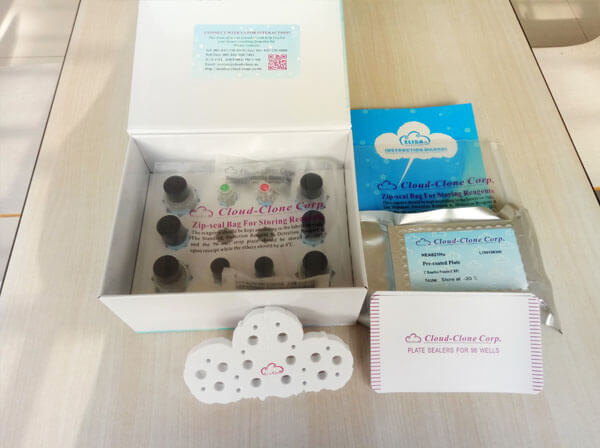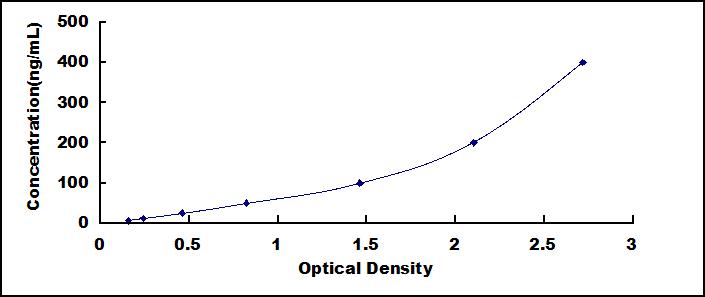Wide-range ELISA Kit for Surfactant Associated Protein D (SPD) 

SFTPD; COLEC7; PSP-D; SFTP4; SP-D; Pulmonary Surfactant Protein D; Collectin-7; Lung surfactant protein D
- UOM
- FOB US$ 312.00 US$ 445.00 US$ 2,003.00 US$ 3,783.00 US$ 31,150.00
- Quantity
Overview
Properties
- Product No.WEB039Hu
- Organism SpeciesHomo sapiens (Human) Same name, Different species.
- ApplicationsEnzyme-linked immunosorbent assay for Antigen Detection.
Research use only - DownloadInstruction Manual
- CategoryInfection immunityPulmonology
Sign into your account
Share a new citation as an author
Upload your experimental result
Review

Contact us
Please fill in the blank.
Recovery
Matrices listed below were spiked with certain level of recombinant Wide-range Surfactant Associated Protein D (SPD) and the recovery rates were calculated by comparing the measured value to the expected amount of Wide-range Surfactant Associated Protein D (SPD) in samples.
| Matrix | Recovery range (%) | Average(%) |
| serum(n=5) | 94-105 | 99 |
| EDTA plasma(n=5) | 80-99 | 91 |
| heparin plasma(n=5) | 78-91 | 84 |
Precision
Intra-assay Precision (Precision within an assay): 3 samples with low, middle and high level Wide-range Surfactant Associated Protein D (SPD) were tested 20 times on one plate, respectively.
Inter-assay Precision (Precision between assays): 3 samples with low, middle and high level Wide-range Surfactant Associated Protein D (SPD) were tested on 3 different plates, 8 replicates in each plate.
CV(%) = SD/meanX100
Intra-Assay: CV<10%
Inter-Assay: CV<12%
Linearity
The linearity of the kit was assayed by testing samples spiked with appropriate concentration of Wide-range Surfactant Associated Protein D (SPD) and their serial dilutions. The results were demonstrated by the percentage of calculated concentration to the expected.
| Sample | 1:2 | 1:4 | 1:8 | 1:16 |
| serum(n=5) | 85-98% | 97-104% | 89-102% | 98-105% |
| EDTA plasma(n=5) | 95-104% | 95-104% | 96-104% | 97-104% |
| heparin plasma(n=5) | 80-97% | 96-103% | 81-97% | 80-90% |
Stability
The stability of kit is determined by the loss rate of activity. The loss rate of this kit is less than 5% within the expiration date under appropriate storage condition.
To minimize extra influence on the performance, operation procedures and lab conditions, especially room temperature, air humidity, incubator temperature should be strictly controlled. It is also strongly suggested that the whole assay is performed by the same operator from the beginning to the end.
Reagents and materials provided
| Reagents | Quantity | Reagents | Quantity |
| Pre-coated, ready to use 96-well strip plate | 1 | Plate sealer for 96 wells | 4 |
| Standard | 2 | Standard Diluent | 1×20mL |
| Detection Reagent A | 1×120µL | Assay Diluent A | 1×12mL |
| Detection Reagent B | 1×120µL | Assay Diluent B | 1×12mL |
| TMB Substrate | 1×9mL | Stop Solution | 1×6mL |
| Wash Buffer (30 × concentrate) | 1×20mL | Instruction manual | 1 |
Assay procedure summary
1. Prepare all reagents, samples and standards;
2. Add 100µL standard or sample to each well. Incubate 1 hours at 37°C;
3. Aspirate and add 100µL prepared Detection Reagent A. Incubate 1 hour at 37°C;
4. Aspirate and wash 3 times;
5. Add 100µL prepared Detection Reagent B. Incubate 30 minutes at 37°C;
6. Aspirate and wash 5 times;
7. Add 90µL Substrate Solution. Incubate 10-20 minutes at 37°C;
8. Add 50µL Stop Solution. Read at 450nm immediately.

Test principle
The test principle applied in this kit is Sandwich enzyme immunoassay. The microtiter plate provided in this kit has been pre-coated with an antibody specific to Wide-range Surfactant Associated Protein D (SPD). Standards or samples are then added to the appropriate microtiter plate wells with a biotin-conjugated antibody specific to Wide-range Surfactant Associated Protein D (SPD). Next, Avidin conjugated to Horseradish Peroxidase (HRP) is added to each microplate well and incubated. After TMB substrate solution is added, only those wells that contain Wide-range Surfactant Associated Protein D (SPD), biotin-conjugated antibody and enzyme-conjugated Avidin will exhibit a change in color. The enzyme-substrate reaction is terminated by the addition of sulphuric acid solution and the color change is measured spectrophotometrically at a wavelength of 450nm ± 10nm. The concentration of Wide-range Surfactant Associated Protein D (SPD) in the samples is then determined by comparing the O.D. of the samples to the standard curve.
Giveaways
Increment services
Citations
- Surfactant protein A and D in chronic rhinosinusitis with nasal polyposis and corticosteroid responseIngenta: art00005
- Evaluation of acute oxidative stress induced by NiO nanoparticles in vivo and in vitroPubMed: 21233593
- Comparison of acute oxidative stress on rat lung induced by nano and fine-scale, soluble and insoluble metal oxide particles: NiO and TiO2PubMed: 22642288
- Detection of surfactant proteins A, B, C, and D in human nasal mucosa and their regulation in chronic rhinosinusitis with polypsPubMed: 23406594
- Staphylococcus aureus and Pseudomonas aeruginosa Express and Secrete Human Surfactant ProteinsPubMed: PMC3551896
- The Detection of Surfactant Proteins A, B, C and D in the Human Brain and Their Regulation in Cerebral Infarction, Autoimmune Conditions and Infections of the CNSPubMed: PMC3787032
- Nachweis und Charakterisierung des Oberfl?chenproteins PLUNC (Palate, Lung and Nasal Clone Protein) an der Augenoberfl?che und Bedeutung für das Trockene AugeOpus4:Source
- The Cerebral Surfactant System and Its Alteration in HydrocephalicConditions.pubmed:27656877
- Correlations of Ventricular Enlargement with Rheologically Active SurfactantProteins in Cerebrospinal Fluid.pubmed:28101052
- Chronic lung injury and impaired pulmonary function in a mouse model of acid ceramidase deficiency.pubmed:29167126
- Rheologically Essential Surfactant Proteins of the CSF Interacting with Periventricular White Matter Changes in Hydrocephalus Patients–Implications for CSF …Doi: 10.1007/s12035-019-01648-z
- Elevated plasma levels of epithelial and endothelial cell markers in COVID-19 survivors with reduced lung diffusing capacity six months after hospital …Pubmed:35189887
- The association between sPD-1 levels versus liver biochemistry and viral markers in chronic hepatitis B patients: a comparative study of different sPD-1 …Pubmed:35361235















